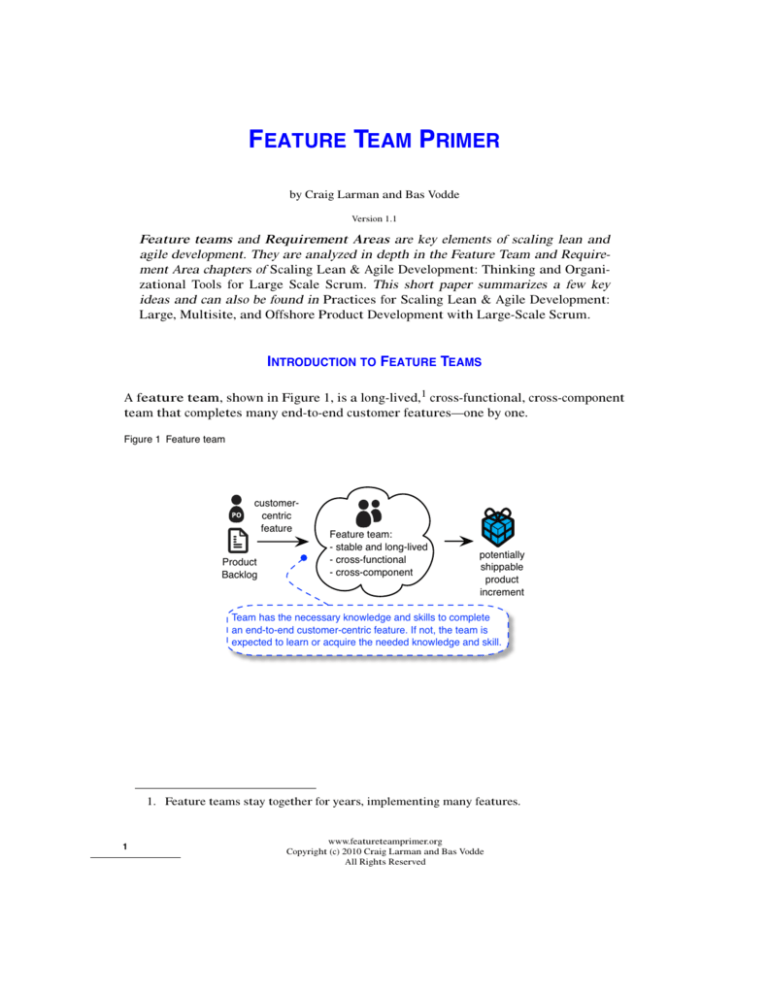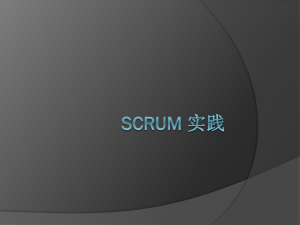
FEATURE TEAM PRIMER
by Craig Larman and Bas Vodde
Version 1.1
Feature teams and Requirement Areas are key elements of scaling lean and
agile development. They are analyzed in depth in the Feature Team and Requirement Area chapters of Scaling Lean & Agile Development: Thinking and Organizational Tools for Large Scale Scrum. This short paper summarizes a few key
ideas and can also be found in Practices for Scaling Lean & Agile Development:
Large, Multisite, and Offshore Product Development with Large-Scale Scrum.
INTRODUCTION TO FEATURE TEAMS
A feature team, shown in Figure 1, is a long-lived,1 cross-functional, cross-component
team that completes many end-to-end customer features—one by one.
Figure 1 Feature team
customercentric
feature
Product
Backlog
Feature team:
- stable and long-lived
- cross-functional
- cross-component
potentially
shippable
product
increment
Team has the necessary knowledge and skills to complete
an end-to-end customer-centric feature. If not, the team is
expected to learn or acquire the needed knowledge and skill.
1. Feature teams stay together for years, implementing many features.
1
www.featureteamprimer.org
Copyright (c) 2010 Craig Larman and Bas Vodde
All Rights Reserved
Feature Team Primer
The characteristics of a feature team are listed below:.
Feature Team
T
long-lived—the team stays together so that they can ‘jell’ for
higher performance; they take on new features over time
T
cross-functional and cross-component
T
ideally, co-located
T
work on a complete customer-centric feature, across all components and disciplines (analysis, programming, testing, …)
T
composed of generalizing specialists
T
in Scrum, typically 7 ± 2 people
Applying modern engineering practices—especially continuous integration—is essential when adopting feature teams. Continuous integration facilitates shared code ownership, which is a necessity when multiple teams work at the same time on the same
components.
A common misunderstanding: every member of a feature team needs to know the
whole system. Not so, because
T
The team as a whole—not each individual member—requires the skills to implement the entire customer-centric feature. These include component knowledge and
functional skills such as test, interaction design, or programming. But within the
team, people still specialize… preferably in multiple areas.
T
Features are not randomly distributed over the feature teams. The current knowledge and skills of a team are factored into the decision of which team works on
which features.
Within a feature team organization, when specialization becomes a constraint…learning happens.
A feature team organization exploits speed benefits from specialization, as long as requirements map to the skills of the teams.
But when requirements do not map to the skills of the teams,
learning is ‘forced,’ breaking the overspecialization constraint.
Feature teams balance specialization and flexibility.
2
www.featureteamprimer.org
Copyright (c) Craig Larman and Bas Vodde 2010
All Rights Reserved
Feature Team Primer
Table 1 and Figure 2 show the differences between feature teams and more traditional
component teams.
Table 1 feature teams vs. component teams
feature team
component team
optimized for delivering the
maximum customer valuea
optimized for delivering the
maximum number of lines of code
focus on high-value features
and system productivity
(value throughput)
focus on increased individual
productivity by implementing
‘easy’ lower-value features
responsible for complete
customer-centric feature
responsible for only part of a
customer-centric feature
‘modern’ way of organizing teamsb
— avoids Conway’s law
traditional way of organizing teams
— follows Conway’s lawc
leads to customer focus, visibility,
and smaller organizations
leads to ‘invented’ work and a
forever-growing organization
minimizes dependencies between
teams to increase flexibility
dependencies between teams leads
to additional planningd
focus on multiple specializations
focus on single specialization
shared product code ownership
individual/team code ownership
shared team responsibilities
clear individual responsibilities
supports iterative development
results in ‘waterfall’ development
exploits flexibility;
continuous and broad learning
exploits existing expertise;
lower level of learning new skills
requires skilled engineering practices—effects are broadly visible
works with sloppy engineering
practices—effects are localized
provides a motivation to make
code easy to maintain and test
contrary to belief, often leads
to low-quality code in component
seemingly difficult to implement
seemingly easy to implement
a. The different optimization often makes the feature team feel
slower—from the local view.
b. Relatively ‘modern’ as feature teams have a long history in
large-scale development, for example, Microsoft and Ericsson.
c. Mel Conway observed this undesirable structure in 1968, he did
not recommended it—in fact, quite the opposite.
d. This additional planning is visible in more “release planning
meetings” or “release trains” and more management overhead.
3
www.featureteamprimer.org
Copyright (c) Craig Larman and Bas Vodde 2010
All Rights Reserved
Feature Team Primer
Figure 2 feature vs. component teams
Component teams
Feature teams
system
system
Product
Owner
Item 1
Item 2
Item 3
Item 4
...
…
comp
A
Team
comp
A
comp
B
Team
comp
B
comp
C
Team
comp
C
Product
Owner
Item 1
Item 2
Item 3
Item 4
...
…
Work from multiple teams is required to finish a
customer-centric feature. These dependencies
cause waste such as additional planning and
coordination work, hand-offs between teams,
and delivery of low-value items.
Work scope is narrow.
Team
Wei
comp
A
Team
Shu
comp
B
Team
Wu
comp
C
Every team completes customer-centric items.
The dependencies between teams are related
to shared code. This simplifies planning but
causes a need for frequent integration, modern
engineering practices, and additional learning.
Work scope is broad.
The table below summarizes the differences between feature teams and conventional
project or feature groups.
Table 2 Feature teams vs feature projects
feature team
feature group or feature project
stable team that stays together for years
and works on many features
temporary group of people created for one
feature or project
shared team responsibility
for all the work
individual responsibility for ‘their’ part
based on specialization
self-managing team
controlled by a project manager
results in a simple single-line
organization (no matrix!)
results in a matrix organization with
resource pools
team members are dedicated—
100% allocated—to the team
members are part-time on many projects
because of specialization
Most drawbacks of component teams are explored in the “Feature Teams” chapter of
Scaling Lean & Agile Development, Figure 3 summarizes some of these.
4
www.featureteamprimer.org
Copyright (c) Craig Larman and Bas Vodde 2010
All Rights Reserved
Feature Team Primer
Figure 3 some drawbacks of component teams
Iteration 1
Iteration 2
(probably later)
Analysis
Backlog Item 1
Backlog Item 2
...
Item 1
Analyst
Iterations 3-5
(probably later
and more)
At least
iteration 6
(probably later)
Design
not available
until the analyst
is finished
System
Engineer
Implementation
not all teams start Item 1
at the same iteration;
they are multitasking on
multiple features
Comp A
Team
Comp B
Team
requirement
details
for Item 1
'backlog' by
component
Test
system testers cannot
start immediately on
Item 1; they are
multitasking on
multiple features
code
Comp
C
Team
System
Testers
Component teams lead to a sequential life cycle with handoff, queues, and
single-specialist groups and not true cross-functional teams without handoff.
What is sometimes not seen is that a component team structure reinforces sequential
development (a ‘waterfall’ or V-model), with many queues with varying-sized work
packages, high levels of WIP, many handoffs, and increased multitasking and partial
allocation.
Choose Component Teams or Feature Teams?
A pure feature team organization is ideal from the value-delivery and organizationalflexibility perspective. Value and flexibility, however, are not the only criterion for
organizational design, and many organizations therefore end up with a hybrid—especially during a transition from component to feature teams. Caution: hybrid models
have the drawbacks from both worlds and can be…painful.
A frequently expressed reason in favor of a hybrid organization is the need to build
infrastructure, construct reusable components, or clean up code—work traditionally
5
www.featureteamprimer.org
Copyright (c) Craig Larman and Bas Vodde 2010
All Rights Reserved
Feature Team Primer
done within component teams. But these activities can also be done in a pure feature
team organization—without establishing permanent component teams. How? By adding infrastructure, reusable components, or cleanup work to the Product Backlog and
giving it to an existing feature team—as if it were a customer-centric feature. The feature team temporarily—for as long as the Product Owner wishes—does such work and
then returns to building customer-centric features.
Transitioning to Feature Teams
Different organizations require different transition strategies when changing from
component to feature teams. We have experience with many strategies that
worked…and failed in a different context. A safe—but slow—transitioning strategy is
to establish one feature team within the existing component team organization. After
this team performs well, a second feature team is formed. This continues gradually at
the speed the organization is comfortable with. This is shown in Figure 3.
Table 3 gradual transitioning from feature to component teams
Product
Owner
Item 1
Item 2
tasks for A
tasks for B
Feature
Team
Red
contains ex-members from component
teams A, B, and C, and from analysis,
architecture, and testing groups
system
Comp A
Team
Component
A
Comp B
Team
Component
B
Comp C
Team
Component
C
Item 3
tasks for A
tasks for B
Item 4
…
…
6
tasks for A
tasks for C
www.featureteamprimer.org
Copyright (c) Craig Larman and Bas Vodde 2010
All Rights Reserved
Feature Team Primer
INTRODUCTION TO REQUIREMENT AREAS
Feature teams scale nicely, but when their number goes above ten teams—about a
hundred people—additional structure is needed. Requirement areas provide this structure and complement the concepts behind feature teams. A requirement area is a
categorization of the requirements leading to different views of the Product Backlog.
The Product Owner (PO) groups every Product Backlog item under exactly one
requirement category—its requirements area. After this, he generates different views
on the overall Product Backlog—called an Area Backlog. The Area Backlogs are prioritized by an Area Product Owner who specializes in part of the product—from a
customer perspective. Each Requirement Area has several feature teams working from
the Area Backlog, as shown in Figure 4.
Figure 4 requirement areas
performance area feature teams
Area
Product
Owner
Product Backlog
Backlog Item 1
…
feature
team
feature
team
feature
team
feature
team
feature
team
feature
team
feature
team
feature
team
feature
team
feature
team
feature
team
Performance
Backlog Items 1
Backlog Items 2
...
Protocols
...
Backlog Item 3
Backlog Item 4
...
Area
Product
Owner
protocols area feature teams
Requirement areas are scaled-up feature teams. Scaling up by structuring teams
according to the product’s architecture is called development areas. Table 4 summarizes the differences.
7
www.featureteamprimer.org
Copyright (c) Craig Larman and Bas Vodde 2010
All Rights Reserved
Feature Team Primer
Table 4 requirement areas vs. development areas
Requirement Area
Development Area
organized around
customer-centric requirements
organized around
product’s architecture
no subsystem code ownership
code ownership per subsystem
temporary in nature;
should change over the lifetime of the
product, but not at every iteration
tends to be more fixed over
the lifetime of the product
focus on the customer,
using customer language
focus on the architecture,
using technology language
Finally, an Area Product Owner is different than a supporting Product Owner—someone that works with one or two teams to help a busy overall Product Owner. An Area
Product Owner has different responsibilities and focus, and works with (probably) at
least four teams, not just with one. This avoids local optimization toward the activities
of one team.
CONCLUSION
Feature teams are stable teams that are given complete customer-centric features.
These teams resolve local optimizations and extra coordination overhead caused by
component team organizations. However, feature teams are not without challenges
themselves.
Requirement areas scale the feature team concept by creating customer-centric views
on the overall Product Backlog and thus creating a structure that allows feature teams
to be scaled up to any size.
8
www.featureteamprimer.org
Copyright (c) Craig Larman and Bas Vodde 2010
All Rights Reserved
Feature Team Primer
REFERENCES
Chapters:
T
Introduction
T
Systems Thinking
T
Lean
T
Queueing Theory
T
False Dichotomies
T
Be Agile
T
Featurea Teams
T
Teams
T
Requirement Areas
T
Organization
T
Large-Scale Scrum
Chapters:
9
T
Large-Scale Scrum
T
Test
T
Product Management
T
Planning
T
Coordination
T
Requirements
T
Design
T
Legacy Code
T
Continuous Integration
T
Inspect & Adapt
T
Multisite
T
Offshort
T
Contracts
www.featureteamprimer.org
Copyright (c) Craig Larman and Bas Vodde 2010
All Rights Reserved









